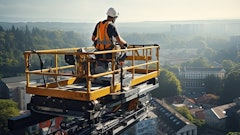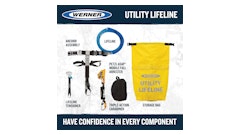
Propane is found on jobsites year round, keeping construction workers safe, warm and powering equipment. With any fuel or construction material, following code and standards and the manufacturers’ instructions is job No. 1 in keeping workers safe and productive.
Local propane suppliers help crews pick the right tank for each application and correctly size, place its use. Construction sites are busy places, always changing and construction professionals need to understand safety.
1. Proper Container Placement
Smaller Department of Transportation (DOT) stationary propane cylinders must be installed 10 feet away from ignition sources and air intakes. Above ground American Society of Mechanical Engineers (ASME) stationary tanks between 125 and 500 gallons water capacity must be installed at least 25 feet from property lines and kept at least 10 feet from ignition sources (such as smoking, sparks and open flames), combustible materials (such as lumber and drywall), building vents or air intake points.
As a project evolves, propane containers may need to be moved to maintain these distances. Check with a local propane supplier before moving stationary ASME tanks around a site or development. The local authority having jurisdiction (AHJ), general contractor, or propane supplier may have additional requirements as to where the container can be placed and if it must be secured. Refer to NFPA 58 for more information on proper container placement.
2. Preventing Tank Damage
Busy construction sites are full of opportunities for dents and other damage to occur on containers of all sizes, especially portable propane cylinders. If an employee notices a dent in a propane container, they should turn off the supply and contact their local propane supplier, who can thoroughly inspect and replace the tank if needed.
To lower the risk of damage and ensure continued safe use, store portable propane cylinders and ASME tanks upright on a flat, stable, and fireproof base. Portable cylinders and tanks may need to be secured with an anchoring system. Crews can also fence off the area around their tanks to reduce the risk of damage from regular site activity or tampering. Cylinders should have caps and collars as well.
3. Using Propane Heaters Indoors
Propane heaters, like any type of fuel supplied heaters, have requirements for adequate ventilation and air to supply the heater. If the manufacturers’ recommendations are not followed, the heater can operate incorrectly or the products of combustion can build up in enclosed areas, producing carbon monoxide (CO), a harmful or potentially deadly gas. Propane heaters should also be kept away from combustibles according to manufacturer’s recommendations.
There are several code requirements designed to avoid propane cylinder container damage and relief valves from activating. These requirements may include:
- Place heaters at least 6 feet from any propane cylinder.
- If more than one cylinder mounted heater is used on the same level of a project, they should be separated by at least 20 feet.
- Do not point a blower or radiant heater toward a cylinder that’s within 20 feet of the heater.
- Cylinders manifolded together to supply a single heater should not exceed 735 pounds water capacity (300-lb. propane capacity).
- Only propane containers under 245 pounds water capacity (100-lb. propane capacity) should be used indoors.
Always refer to building code for more information on safely handling, using, and storing propane containers for temporary heat in buildings under construction, small propane cylinders should be removed from buildings when not in use and it is always a good practice to have a centralized storage point for cylinders where they are protected from being damaged by equipment and vehicles.
4. Protecting Tanks During Storms
Construction crews should have a checklist ready to be prepared for bad weather on a jobsite. Propane containers need to be secured or removed from the site during storms, with the assistance of a propane supplier. Additionally, remove materials and equipment that could fall on and damage a propane container.
5. Spotting, Handling Leaks
It’s important to make sure everyone on site—even those who aren’t working directly with propane—are familiar with propane safety procedures and what to do in the event of a leak.
Propane is naturally odorless and nontoxic, so a chemical odorant is added to help detect leaks. If employees get a whiff of rotten eggs or a strong sent like a skunk’s spray, there may be a propane leak. If a leak is found, the propane tank(s) should be turned off, everyone should be kept away from the area affected by the leak, and the propane supplier should be called.
6. Carbon Monoxide Protection
Construction professionals need to be aware of potential carbon monoxide issues when using any internal combustion engine-powered equipment in an enclosed space. They should ensure the equipment is designed for indoor use, and make sure to have proper ventilation.
According to the Centers for Disease Control and Prevention, more than 400 workers die every year from unintentional CO poisoning and more than 4,000 others are hospitalized. The Occupational Safety and Health Administration (OSHA) notes that one of the most common sources of CO exposure in the workplace is the internal combustion engine.
Fortunately, propane can offer a safe alternative to gasoline- and diesel-powered small-engine jobsite applications that are often the culprit to employees getting sick. In fact, propane small-engine applications can reduce CO emissions by up to 50% compared with gasoline models, according to data from PERC.





























